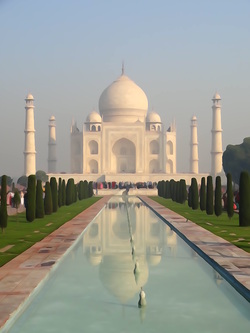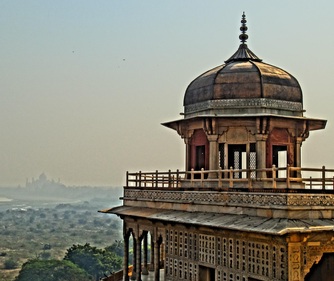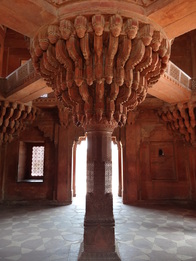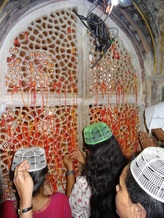



If you read our previous post about New Delhi, you would know that we were feeling pretty harried with all the machinations required to book our travel through the “Golden Triangle” of Delhi to Agra to Jaipur and back. After many attempted scams, our driver did arrive on Saturday morning and we felt a swelling of relief that the ordeal was over. The driver, Rimesh, seemed like an affable fellow who spoke good English. He was telling us about how his family lives north in the mountains and how he works in Delhi to support them. Then, he pulled over on the side of the road and said, “My wife only visits a few times a year from the mountains and one of those times is during Diwali (the Indian Festival of Lights). So my cousin Kirssna will be your driver. We’ll just pull over here and pick him up.” Uh, oh. Our frazzled nerves from the previous few days had us wary of any changes that we hadn’t been told about. But we had little choice and a call to our travel agent assured us it wasn’t a problem. But in the end the change to Kirssna as a driver seemed to shroud the whole journey under a veil of bad luck. Kirssna spoke much less English than his cousin and as we petered out of traffic-congested Delhi with mosquitoes flying through our car, we discovered upon closing the windows that our “air conditioned” car had no working AC. Kirssna attempted to get it fixed at a road side shop, but in the end this only succeeded in killing off the alternator, leaving us broken down on the side of the road about 45 minutes from Agra. After a sweltering 2 – 3 hour wait for the waiting for a different car sent by the travel agency to pick us up, a 4-6 hour journey had ballooned into a 10 hour one and we were exhausted. Still, the drivers of the new car at least gave us a taste of what the region had to offer as we stopped in Sikandra to view the tomb of Akbar the Great, the Mughal Philosopher King who was uncommonly tolerant of different religions and viewpoint within his realm. He penned a philosophy known as Din-i-llahi (Faith of God), that spoke of the unifying thread of truth found in all religions. His mausoleum, which predates the Taj Mahal by several generations, is an imposing and delightful blend of red sandstone inlaid with marble geometric patterns that harkened us back to our travels through Andalusia. Though we hadn’t anticipated seeing it so late in day, as the sun set over the ancient tomb the sandstone blazed forth as if on fire and the visual effect was such that we instantly felt glad we had continued on this journey that seemed plagued with problems. That sentiment quickly eroded as, despite our exhaustion, the drivers insisted on taking us to a marble making shop, where an interesting description of the techniques used at the Taj Mahal to inlay the marble with semi-precious stones (called pietra dura) was followed by a harsh and hard sell by the shopkeeper. Insisting we were too tired to even think of shopping, we left the shop with a curse at our backs and feeling that the goodwill in India was in short supply. We were unceremoniously dumped at our hotel and our failed calls to our driver left little choices for dinner save the Pizza Hut next door. Just a few days in India and we were already eating at our second chain due to simply being unable to find authentic restaurants! It was fun however, to see the unique Indian items like the Spicy Paneer Quesadillas and Chicken Tikka Masala Pizza. We headed to bed early in anticipation of our sunrise viewing of the Taj. As morning came, we sat outside our hotel futilely trying to contact our driver. Realizing he wasn’t coming and that we would miss the sunset, we hired a private rickshaw and headed to the Taj ourselves. The sun was just lifting from the sky and we trundled through the massive red sandstone gate to get our first glimpse of this wonder of the world. And a wonder it is. The great Indian Poet, Rabindranath Tagore once likened the Taj to “A Teardrop on the Face of Eternity”. We stood gazing the at the wondrous sweeping curves of its onion-like white marble dome glowing sweetly to greet the new day. Its towering minarets stand guard over the tomb of Mumtaz Mahal and the view of the background sky is totally clean due to the huge elevated marble platform the Taj sits upon. The tourists surrounding us fell away. Time fell away. And for a moment there was just the beauty of this thing captivating our minds, flowing through our hearts.  The Taj Mahal was built by the great Mughal builder Shah Jahan upon the loss of his wife after the birth of their 14th child. It took 20,000 craftsmen and workers from all over the world 22 years to finish the masterpiece – a building meant to represent the heavenly realm where Shah Jahan’s wife rested. In this way, it had parallels to the gorgeous palace of the Alhambra, which was an attempt by the Sultans there to create heaven on earth. What is most striking about the place is not something that can be captured in pictures. It is the juxtaposition that strikes one when in its presence. It both instills a deep peace at its beauty but also calls forth the yearning for love each of us feels – that makes each of us human. After the ordeal of the past few days, it felt like the Taj gave us that gift – it made us feel human again. We found ourselves laughing and joking as we left, energized by the visit and determined to feed our pain bodies no longer, but to embrace this trip no matter what it brought us.  Nice view for a prison The rest of the day breezed by with a stream of marvelous sites. We finally located and were picked up by our driver, got a great breakfast of boiled eggs, herbed parathas, and dal in our bellies, and headed to Agra Fort, built by the aforementioned Akbar and retrofitted by his grandson Shah Jahan. Like the Red Fort in Delhi, Agra Fort started as a military base and later became a palace where royal affairs were carried out. Perhaps the most striking building at the fort was the Khas Mahal, a wonderfully carved marble palace that became the prison of Shah Jahan when his son Aurangzeb seized the throne and threw his father in prison. I found great irony in this because Shah Jahan is said to have immediately slain all competitors to his throne upon coming to power. But despite all this violence and grasping, his own karma came back to haunt him as the one person he wouldn’t slay, his son, seized the throne from him. His perch in the palace-turned-jail, however, did provide a stunning view of the Taj over the Yamuna River where Shah Jahan could look at his beloved each day. From Agra Fort, we headed 40km west of Agra where we stopped at Fatehpur Sikri, an abandoned city built by the ubiquitous Emperor Akbar. Akbar built this city out in the boondocks in honor of the Sufi Shaikh Salim Chisti, who had prophesized here that Akbar would father an heir to the Mughal throne. When the prophecy came true, Akbar set out to build this “perfect city” of good fortune and move his capital there. The plan only lasted for 15 years, after which Akbar died and the chronic water shortages of the area left the city abandoned for the more consistent water supply that had existed in Agra.  Diwan-i-Khas The result is an eerie city that had become a ghost-town within the same generation it was constructed. Our favorite site in the palace complex of the city was the Diwan-i-Khas (Hall of Private Audiences) with its intricately carved planked ceiling connecting a grouping of “wasps nests” at the 4 corners of the room and in the center. The hall was used for one of Akbar’s favorite pastimes – religious debate and discourse. We also loved the Panch Mahal, a five-story pavilion that reduces in size each floor until only a small gazebo remains. From there, Akbar relaxed while playing pachisi using his slave girls as pieces. This guy was certainly living up an Emperor’s life!  Finally we left the palace complex and headed to the great mosque of Jama Masjid, which contains the beautiful white marble tomb of Shaikh Salim Christi. His descendants still maintain the tomb and it is a flocking point for pilgrims wishing to bear children. Wishing for the good fortune the Sufi saint bestowed upon Akbar, they come to his mausoleum to offer prayers and tie little red strings around the lattice-work marble screens surrounding his tomb. By the time we got back into the car and started our 5 hour journey to Jaipur, we were exhausted but invigorated. The remains of the Mughal empire around Agra were a legacy of beauty, the celebration of life, and the many reminders of its impermanence. We looked forward to the next stop in the Golden Triangle, where we would celebrate Diwali in the Pink City of Jaipur and try out Couchsurfing in India for the first time!
1 Comment
saleem khan
11/17/2012 05:20:29 pm
oh my GOD very good photography,, Leave a Reply. |